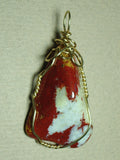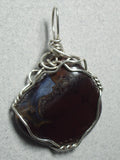JASPER
HARDNESS: 7
DENSITY: 2.65
FORMULA: SiO2
 |
| Pigeon Blood Jasper at jemelww.com |
- COLOR/DESCRIPTION: Very broad range of colors, almost any color or combination of colors
possible. The most common colors are red, yellow, green, black, brown, caramel and white. Jasper is the name given to the group of the opaque varieties of chalcedony. It takes a high glossy polish and is most valued for its earth tone colors and scenic patterns.
- LOCATION/ORIGIN: Many locations; formed in sedimentary and igneous (volcanic) environments as microcrystalline precipitates from aqueous solutions, dehydration of opal or low-temperature volcanic activity, often filling cavities in cooling lava.
- HISTORY/FOLKLORE/USES: Jasper was one of the stones set in the breastplates of the high priests of Israel in ancient times. Folklore suggests that it was highly regarded as a bringer of rain. It was also believed to drive away evil spirits from the wearer and protect from and draw out poisonous venoms.
- ZODIAC: Leo and Taurus
- EMOTION/MOOD: Nurturing stone, methodical consistency, stress relief, endurance, general healing and health maintenance, concentration and sharp focus on long-term goals.
- OCCUPATION: Advertising, Chiropractor, Communications, Executive, Guard or Policeman, Management, Politician, Scientist, Veterinarian.
A JASPER TALE
 |
| Hema Jasper at jemelww.com |
Your body is tired, sore and feels completely worn out. It’s begging and pleading with you to take it home for a warm bath and a long rest. You won’t give in to it. You can’t give in to it. You haven’t completed your goal or finished your course. Your mind insists that you do so before letting your body have its way.
You are now at the base of a towering wall of rock. The finish line is only to be found at its top. Your body is arguing that it is an impossible task, but you’ve made your decision in advance and your mind is determined to keep the promise. So you begin.
You put on your rock shoes, attach your harness, secure your rack, stake your first anchor and complete a body check to make sure you haven’t forgotten some simple set-up step that could take your life.
You’re now clinging to the granite face about twenty feet up when John and a few wall rat friends arrive at the base. They holler a few jeers at you. You stretch and grunt to maneuver to a crack. You jam a cam in the slit, clip your rope and return to methodical concentration. You are somewhat relieved that John now holds the rope below to secure your safety. You twist and contort your body around a jutting ridge in the wall and pull yourself up onto a flattop. You drill and bolt a firm anchor and establish a belay point here.
Andrea is beginning her ascent, soon to be followed by the others. You wait and watch for a while, then begin climbing the next leg of your journey up the massive monolith. You arrive at the base of a chimney, pin your body between its walls and edge your way up the dark narrow opening. You find another flattop at its end and establish another belay point. You take a glance at your watch. You’ve been climbing for over two hours. You stare up along the sharp steep wall and into the sky. You cannot see the top, though you feel it drawing near. You chalk your hands in preparation for the
 |
| Picture Jasper at jemelww.com |
You move up the final length of the wall slowly and meticulously, continually careful to maintain hand and foot holds. You are forced to take more time to drill and set bolts. You find yourself often in many awkward positions. You enjoy putting your body into them; it’s part of the thrill of the course. You must traverse along the wall now to ascend a better route. You slide across the smooth flat surface periodically anchoring your rope. You discover a thin crack. You thrust in a ball nut for protection and continue in like manner along this line to the top.
You are exhausted but elated. A new source of energy fills your being. You have conquered this great stone. You have finished a competition with yourself and won. You wait for the others, they all arrive within an hour and you celebrate your personal and group conquest together in quiet peaceful enjoyment of a panoramic view of the beautiful world around you.
Copyright 2015 Steven A. Barben
Find Jasper pendants at jemelww.com
General References:
Pough, Frederick. 1983. Peterson Field Guides: A Field Guide to Rocks and Minerals.
Houghton Mifflin Co.
Mottana, Annibale; Crespi, Rodolfo; and Liborio, Giuseppe. 1978. Simon & Shuster’s Guide
to Rocks and Minerals. Simon & Shuster Inc.
Sullivan, Kevin. 1987. The Crystal Handbook. Armadillo Press.
Note: Minor sources may include, but are not limited to a variety of printed and online sources.
“An Jasper Tale” is an original story by Steven A. Barben – author of this blog.




